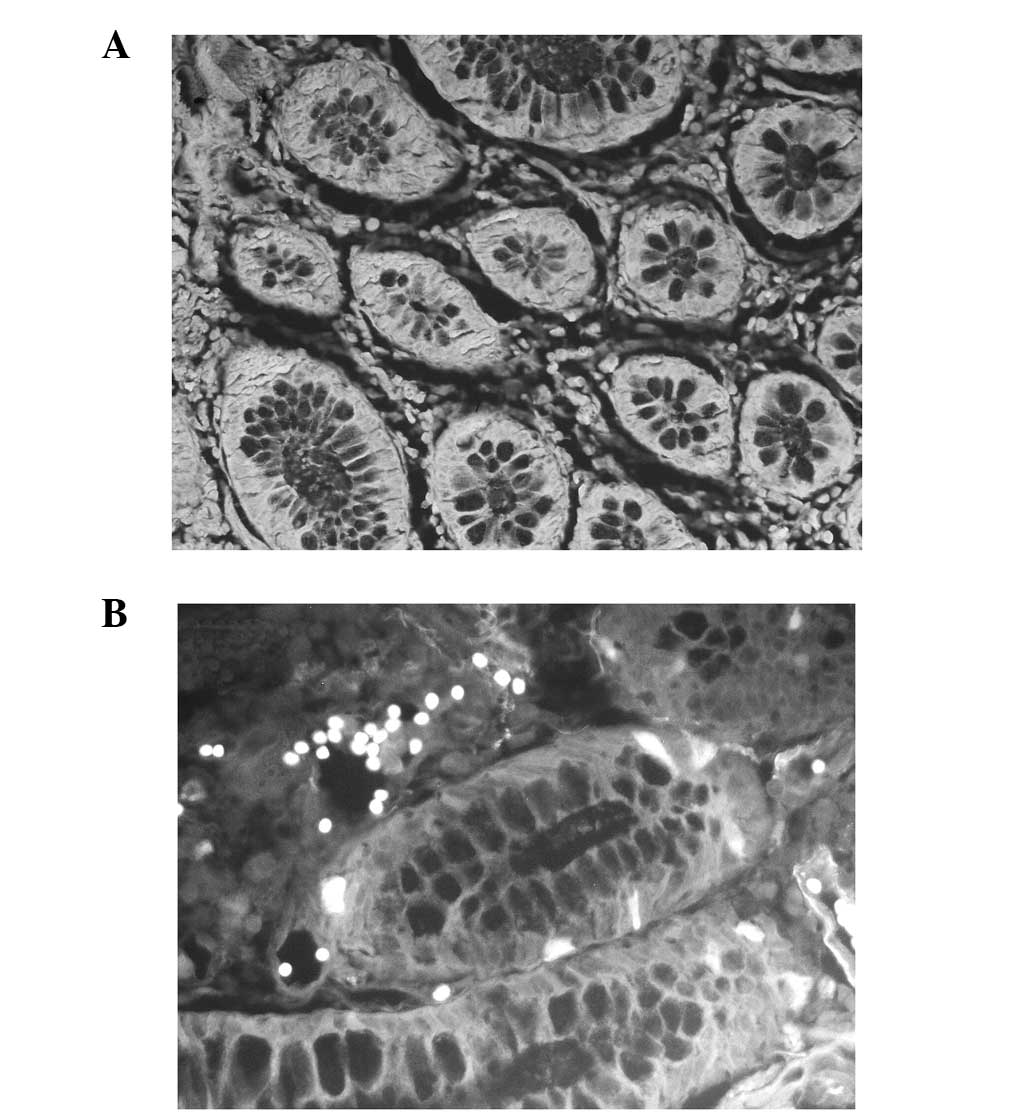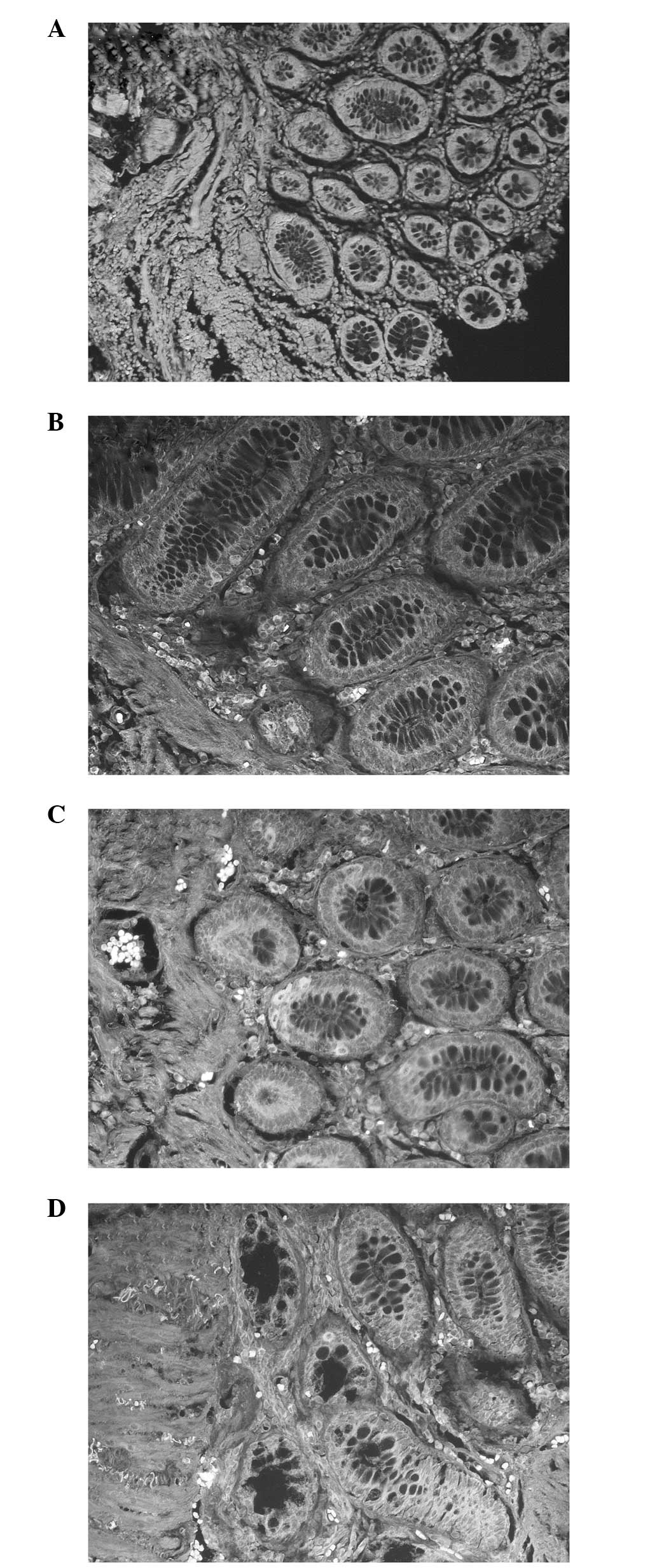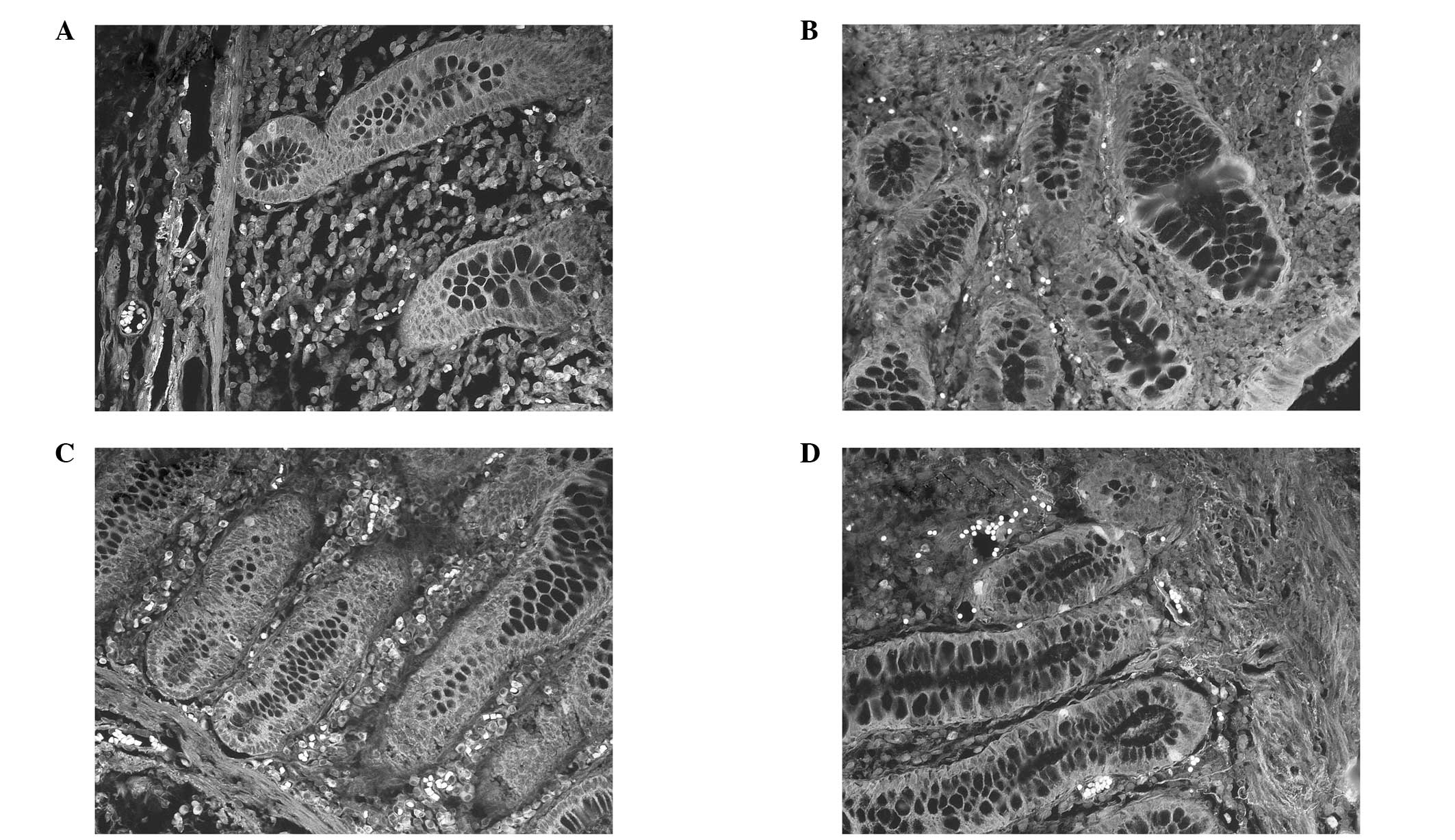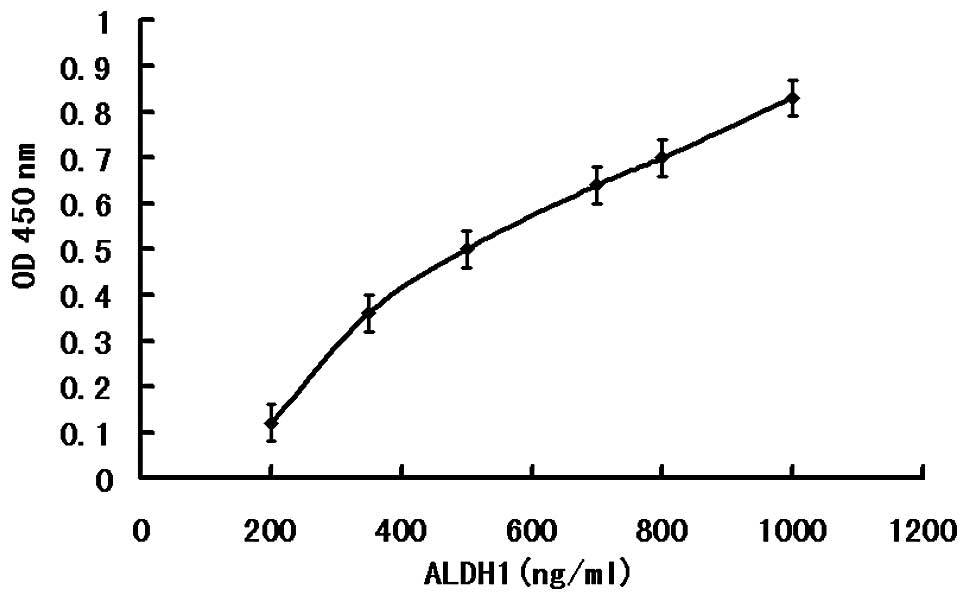Aldehyde dehydrogenase 1: A specific cancer stem cell marker for human colorectal carcinoma
- Authors:
- Published online on: January 13, 2015 https://doi.org/10.3892/mmr.2015.3195
- Pages: 3894-3899
Abstract
Introduction
Colorectal carcinoma (CRC) comprises colon and rectal cancer and is one of the most common types of malignant digestive tract tumor in humans. It is the fourth most common type of cancer in males and the third most common cancer in females worldwide (1). CRC is one of the major causes of cancer-associated mortality (2). In general, CRC incidence rates continue to increase in developing countries, whereas incidence rates are stabilizing or decreasing in developed countries. The increase of CRC in developing countries may reflect the adoption of western lifestyles and behaviors, including the consumption of high-fat diets, physical inactivity and smoking (3,4). It has been established that cancer stem cells (CSCs) have a phenotype that can be defined by their cell of origin [stem cell (SC) or early progenitor cells] and by oncogenic events, which contribute to their transformation (5). Certain studies have provided evidence to support this concept (5,6). One approach for identifying shared SC markers is to focus on conserved stem and progenitor cell functions, which may be inherited by the malignant SC compartment.
Aldehyde dehydrogenase 1 (ALDH1) is a detoxifying enzyme responsible for the oxidation of intracellular aldehydes (7–10). ALDH1 thereby confers resistance to alkylating agents (11). Through its role in oxidizing retinol to retinoic acid, ALDH1 is important in the early differentiation of SCs (12). It has been demonstrated that murine and human hematopoietic and neural stem and progenitor cells have a high ALDH1 activity (13–16). Increased ALDH1 activity has also been identified in SC populations in multiple myeloma and acute myeloid leukemia (16,17). Thus, ALDH1 activity may provide a common marker for normal and malignant stem and progenitor cells. Previous observations have suggested that ALDH1 is a marker for CSCs in various types of malignancy and that ALDH1 in CSCs is associated with chemoresistance and an increased potential for malignancy (18–24).
Previous immunohistochemistry results demonstrated that ALDH1 expression was higher in breast and lung cancer compared with normal tissue (25,26), while in malignant ovarian tumors expression levels were lower than that in normal ovaries (27). However, to the best of our knowledge, whether the expression of ALDH1 in human CRC is associated with clinicopathological features and the differentiation of tumor cells has not previously been investigated. Thus, the present study aimed to elucidate whether the expression of ALDH1 is a significant clinicopathological prognostic factor in patients with CRC using immunofluorescence staining and enzyme-linked immunosorbent assay (ELISA).
Materials and methods
Patients and tissue specimens
The fresh tissues of primary CRCs were obtained from the Department of Pathology at the Red Flag Hospital Affiliated to Mudanjiang Medical College (Mudanjiang, China) between January 1, 2010 and October 20, 2012. Prior to surgery, none of the patients involved in the present study had received any type of therapy, including radiation or chemotherapy. Of these tumor specimens, 20 were well differentiated, 20 were moderately differentiated, 20 were poorly differentiated and 10 were mucinous carcinomas. A total of 20 fresh samples were collected for ELISA, including 10 colorectal tissues and 10 corresponding adjacent normal mucous tissues (>5 cm from the margin of the tumor), which were stored at −80°C until use. All tissue samples were fixed in formalin, embedded in paraffin and deparaffinized for immunofluorescence staining. Written informed consent was obtained from the patient’s families and all protocols were reviewed and approved by the Ethical Committee of Mudanjiang Medical College.
Indirect immunofluorescence
Indirect immunofluorescence was performed as previously described (28). The sections were rinsed with Tris-buffered saline (TBS; Sigma-Aldrich, Shanghai, China) and blocked in buffer for 30 min in a humidified chamber at 37°C. For ALDH1 staining, the sections were incubated at 4°C overnight with a rabbit monoclonal anti-ALDH1 antibody (1:400; EarthOx; cat no. HZ348711). The slides were then incubated with a fluorescent-conjugated monoclonal secondary antibody (1:150; EarthOX; HZ369731; 30 min; 37°C; Fluor 491–520 nm). Following incubation with the secondary antibody, the sections were rinsed three times with TBS and Tween 20 and then coverslipped. Finally, the samples were examined by fluorescence microscopy (Nikon Eclipse 80i; Nikon, Tokyo, Japan). The assessed tumor area, based on immunofluorescence staining, was used to calculate the density of the positive cell staining.
Evaluation of labeling
Evaluation of the immunofluorescence staining for ALDH1 expression was performed independently by two pathologists. Imaging analysis of the colorectal tumors for ALDH1 expression was performed in one selected area (magnification, ×200) per case.
ELISA for ALDH1
The ALDH1 levels in tissue homogenate of the tumor tissue were quantified using a commercially available ELISA kit (Tianjin Haoyang Biological Manufacture Co., Ltd., Tianjin, China), according to the manufacturer’s instructions. An ELISA standard curve was generated and then according to the optical density data, the ALDH1 content of the normal and malignant tumor tissues was determined.
Statistical analysis
All the data were analyzed using SPSS software version 11.0 for Windows (SPSS, Inc., Chicago, IL, USA). The association between ALDH1 immunofluorescence expression and the clinicopathological parameters was evaluated using the χ2 test. P<0.05 was considered to indicate a statistically significant difference. The association of ALDH1 content between primary colorectal tissues and normal colorectal tissues was assessed using the Pearson χ2 test. P<0.001 was considered to indicate a statistically significant difference.
Results
Patient characteristics
A total of 70 patients were enrolled in the present study; 50% were male (35 of 70) and 50% were female (35 of 70). The median age of the patients was 61.7 years (range 22–80 years). A total of 45 (64.2%) patients were >60 years old and 25 (35.7%) were <60 years old. The diagnosis in all patients was colorectal adenocarcinoma and was classified by the degree of tumor cell differentiation (well, moderately or poorly differentiated). Of the 70 patients, 20 patients (28.5%) had well-differentiated tumors, 20 (28.5%) had moderately differentiated tumors, 20 (28.5%) had poorly differentiated tumors and 10 (14.3%) had mucinous carcinomas. A total of 29 patients were at Dukes’ stage A+B (41.4%) and 41 patients were at Dukes’ stage C+D (58.5%). According to the tumor-node metastasis (TNM) staging system, 10 patients (14.3%) were at stage I, 19 patients (27.1%) were at stage II, 32 patients (45.7%) were at stage III and 9 patients (12.9%) were at stage IV. Lymph node metastases were present in 36 patients (51.4%) and absent in 34 patients (48.6%; Table I).
ALDH1 expression in normal colorectal tissue and CRC tissue
Compared with normal colorectal tissue, CRC tissue exhibited markedly higher levels of ALDH1 protein expression. Normal mucosal specimens at least 5 cm distant from the primary colorectal carcinomas were obtained from 10 patients with CRC. ALDH1 was detected in the cytoplasm of the CRC tissue and certain normal colorectal tissue. Staining was observed in the cytoplasm of the epithelial cells. In the 10 normal controls, ALDH1 reactivity was demonstrated in ~10% of the epithelial cells. Of the 70 colorectal cancer specimens, a high rate of positive staining was observed (≥20%). Patients exhibiting ≥20% positive cells were classified as ALDH1 positive and the remainder as ALDH1 negative. The results of the immunofluorescence staining for ALDH1 in the normal colorectal tissue and the CRC tissue are shown in Fig. 1.
Correlation between ALDH1 positive expression and various clinicopathological features
The association between ALDH1 protein and the clinicopathological features of the CRC patients are summarized in Table II. No significant correlation was identified between ALDH1 expression and age, gender, tumor size or lymph node metastasis. ALDH1 expression, however, was closely associated with the differentiation of tumor cells. The results revealed that the greater the degree of differentiation of the tumor cell, the lower the rate of ALDH1 staining. A higher ALDH1 band intensity was detected in the poorly differentiated malignant tumors (Fig. 2A) compared with the mucinous carcinomas and well or moderately differentiated tumors (Fig. 2B–D). A positive correlation was observed between the differentiation of tumor cells and the proportion of ALDH1 immunostained cells (χ2=16.43; P<0.05) among the examined samples. Of the 10 mucinous carcinoma cases, three ALDH1 positive cases were noted. Of the 20 well-differentiated cases, ALDH1 expression was noted in 7 cases (35%). Of the 20 moderately differentiated cases, ALDH1 expression was noted in 13 cases (65%) and of the 20 poorly differentiated cased, ALDH1 expression was noted in 18 cases (90%). Dukes’ C+D stages demonstrated a higher expression rate of ALDH1 (70.7%) compared with Dukes’ A+B stages (41.4%; P<0.05). Using the TNM staging system, positive staining of the ALDH1 protein was identified in 3 out of the 9 cases of TNM stage I (33.3%); 9 cases were identified in 20 of the TNM stage II samples (45%); 21 cases were identified in 32 of the TNM stage III samples (65.6%) and 8 cases were identified in 9 of the TNM stage IV samples (88.9%; χ2=7.94; P<0.05). The immunofluorescence staining for ALDH1 expression in various TNM stages is shown in Fig. 3.
Table IICorrelation between ALDH1 positive expression and various clinicopathological features in colorectal carcinoma patients. |
Quantitative detection of ALDH1 in CRC tissue and in normal colorectal tissue
According to the ELISA kit instructions, an ELISA standard curve was drawn (Fig. 4), and then according to the standard curve, the levels of ALDH1 in the normal and malignant tumor tissues were calculated. In the CRC tissue, the content of ALDH1 was 559.0±151.76 ng/ml, whereas, in normal colorectal tissue, the content of ALDH1 was 298.6±58.43 ng/ml. Using a Pearson χ2 test (t=5.064; P<0.001; Table III), the ALDH1 content was found to be significantly increased in the human colorectal cancer tissue compared with the normal colorectal tissue.
Table IIIQuantitative results of ALDH1 in colorectal carcinoma tissue and in normal colorectal tissue. |
Discussion
The cancer stem cell theory was initially proposed by Hamburger and Salmon (29), who demonstrated that only a small percentage of tumor cells was able to form colonies in soft agar. According to the CSC hypothesis, cancer originates from SCs that exhibit pluripotency and self-renewal (30). CSCs are hypothesized to lead to the initiation, progression and recurrence of cancer. Certain tumor-initiating cells share common cell surface markers, leading to their designation as SCs (18).
CSCs can be defined by the cell of origin (SCs or early progenitor cells). Identifying the normal and malignant stem/progenitor cells by the same marker, supports the hypothesis that stem and progenitor cells are primary targets of transformation, and also adds further evidence to the cancer stem cell hypothesis. The candidate marker ALDH1 is a good choice, which is in accordance with the above theory that CSCs can be defined by the cell of origin (SCs) (21).
One key finding of the present study was that, compared with the normal colorectal tissues, the tumor tissues expressed a high rate of ALDH1 staining (≥20%). A second key finding of the present study was the correlation between the differentiation degree of the tumor cell and the expression of ALDH1. Through indirect immunofluorescence staining, it was demonstrated that with decreased differentiation (from well to poorly differentiated), the ALDH1-positive staining rates increased (χ2=16.43; P<0.05). The reason for mucinous carcinoma exhibiting the lowest staining rate may be attributed to the mucago of mucinous carcinomas affecting the staining of ALDH1 in cancer cells. The results also suggested that poorly differentiated cancer cells expressed increased colorectal SCs compared with well-differentiated cells. These findings supported those of Huang et al, which revealed that the overall proliferative cell population increases during colorectal tumorigenesis (19). A third important finding was that low-grade tumors exhibited higher expression of ALDH1 compared with high grade tumors (P<0.05). Additionally, Dukes’ C+D stages demonstrated a higher expression of ALDH1 compared with Dukes’ A+B stages (P<0.05). Western blotting was used to determine the protein content of ALDH1, however, no significant findings were obtained. Considering that the protein content was small, ELISA was used to analyze the content of ALDH1 in fresh CRC tissues. Through an ELISA assay, the present study also found an increased level of ALDH1 in CRC tissues compared with normal colorectal tissues.
In conclusion, the present study supported the CSC hypothesis by demonstrating that normal and malignant SCs share a common functional marker. As a CSC marker shared by normal colorectal tissues and CRC tissues, ALDH1 may be important in CRC carcinogenesis and may be used as an important marker for CSC. It can be regarded as a valuable marker in CRC patients and, through detecting the content of ALDH1, may assist in the differentiation of colorectal carcinogenesis from normal colorectal tissues. At present, ALDH1 is attracting increased attention, however, whether ALDH1 negative cells also possess the same ability as SCs has yet to be elucidated. As the sample size of the present study was limited, further studies with larger samples are warranted to assess the possibility that ALDH1 expression may be used in the pathological evaluation of tissue histology to predict disease prognosis and the response to chemotherapy in patients with CRC.
Acknowledgements
The authors would like to thank Dr Ying-Wu of the Red Flag Hospital Affiliated to Mudanjiang Medical College (Mudanjiang, China) for her contribution to experiments and data and Ms. Jia-Ning Qiu of Jilin University (Changchun, China) for her linguistic contributions. This study was supported by project grants from the Science and Technology Department of Heilongjiang Province in China (grant no. D201259).
Abbreviations:
|
ALDH1 |
aldehyde dehydrogenase 1 |
|
CRC |
colorectal carcinoma |
|
CSC |
cancer stem cell |
|
IFAS |
indirect florescence antibody staining |
|
ELISA |
enzyme-linked immunosorbent assay |
|
SC |
stem cell |
|
AML |
acute myeloid leukemia |
References
|
Center MM, Jemal A and Ward E: International trends in colorectal cancer incidence rates. Cancer Epidemiol Biomarkers Prev. 18:1688–1694. 2009. View Article : Google Scholar : PubMed/NCBI | |
|
Jemal A, Siegel R, Xu J and Ward E: Cancer statistics, 2010. CA Cancer J Clin. 60:277–300. 2010. View Article : Google Scholar : PubMed/NCBI | |
|
Long N, Moore MA, Chen W, Gao CM, Lai MS and Mizoue T: Cancer epidemiology and control in north-east Asia - past, present and future. Asian Pac J Cancer Prev. 11:107–148. 2010.PubMed/NCBI | |
|
Peppone LJ, Mahoney MC, Cummings KM, et al: Colorectal cancer occurs earlier in those exposed to tobacco smoke: implications for screening. J Cancer Res Clin Oncol. 134:743–751. 2008. View Article : Google Scholar : PubMed/NCBI | |
|
Jamieson CH, Ailles LE, Dylla SJ, et al: Granulocyte-macrophage progenitors as candidate leukemic stem cells in blast-crisis CML. N Engl J Med. 351:657–667. 2004. View Article : Google Scholar : PubMed/NCBI | |
|
Kelly LM and Gilliland DG: Genetics of myeloid leukemias. Annu Rev Genomics Hum Genet. 3:179–198. 2002. View Article : Google Scholar : PubMed/NCBI | |
|
Duester G: Families of retinoid dehydrogenases regulating vitamin A function: production of visual pigment and retinoic acid. Eur J Biochem. 267:4315–4324. 2000. View Article : Google Scholar : PubMed/NCBI | |
|
Magni M, Shammah S, Schiró R, et al: Induction of cyclophosphamide-resistance by aldehyde-dehydrogenase gene transfer. Blood. 87:1097–1103. 1996.PubMed/NCBI | |
|
Sophos NA and Vasiliou V: Aldehyde dehydrogenase gene superfamily: the 2002 update. Chem Biol Interact. 143–144:5–22. 2003. View Article : Google Scholar | |
|
Yoshida A, Rzhetsky A, Hsu LC and Chang C: Human aldehyde dehydrogenase gene family. Eur J Biochem. 251:549–557. 1998. View Article : Google Scholar : PubMed/NCBI | |
|
Dylla SJ, Beviglia L, Park IK, et al: Colorectal cancer stem cells are enriched in xenogeneic tumors following chemotherapy. PLoS One. 3:e24282008. View Article : Google Scholar : PubMed/NCBI | |
|
Chute JP, Muramoto GG, Whitesides J, et al: Inhibition of aldehyde dehydrogenase and retinoid signaling induces the expansion of human hematopoietic stem cells. Proc Natl Acad Sci USA. 103:11707–11712. 2006. View Article : Google Scholar : PubMed/NCBI | |
|
Armstrong L, Stojkovic M, Dimmick I, et al: Phenotypic characterization of murine primitive hematopoietic progenitor cells isolated on basis of aldehyde dehydrogenase activity. Stem Cells. 22:1142–1151. 2004. View Article : Google Scholar : PubMed/NCBI | |
|
Hess DA, Meyerrose TE, Wirthlin L, et al: Functional characterization of highly purified human hematopoietic repopulating cells isolated according to aldehyde dehydrogenase activity. Blood. 104:1648–1655. 2004. View Article : Google Scholar : PubMed/NCBI | |
|
Hess DA, Wirthlin L, Craft TP, et al: Selection based on CD133 and high aldehyde dehydrogenase activity isolates long-term reconstituting human hematopoietic stem cells. Blood. 107:2162–2169. 2006. View Article : Google Scholar | |
|
Matsui W, Huff CA, Wang Q, et al: Characterization of clonogenic multiple myeloma cells. Blood. 103:2332–2336. 2004. View Article : Google Scholar | |
|
Pearce DJ, Taussig D, Simpson C, et al: Characterization of cells with a high aldehyde dehydrogenase activity from cord blood and acute myeloid leukemia samples. Stem Cells. 23:752–760. 2005. View Article : Google Scholar : PubMed/NCBI | |
|
Deng S, Yang X, Lassus H, et al: Distinct expression levels and patterns of stem cell marker, aldehyde dehydrogenase isoform 1 (ALDH1), in human epithelial cancers. PLoS One. 5:e102772010. View Article : Google Scholar : PubMed/NCBI | |
|
Huang EH, Hynes MJ, Zhang T, et al: Aldehyde dehydrogenase 1 is a marker for normal and malignant human colonic stem cells (SC) and tracks SC overpopulation during colon tumorigenesis. Cancer Res. 69:3382–3389. 2009. View Article : Google Scholar : PubMed/NCBI | |
|
Li T, Su Y, Mei Y, et al: ALDH1A1 is a marker for malignant prostate stem cells and predictor of prostate cancer patients’ outcome. Lab Invest. 90:234–244. 2010. View Article : Google Scholar | |
|
Ginestier C, Hur MH, Charafe-Jauffret E, et al: ALDH1 is a marker of normal and malignant human mammary stem cells and a predictor of poor clinical outcome. Cell Stem Cell. 1:555–567. 2007. View Article : Google Scholar | |
|
Ma S, Chan KW, Lee TK, et al: Aldehyde dehydrogenase discriminates the CD133 liver cancer stem cell populations. Mol Cancer Res. 6:1146–1153. 2008. View Article : Google Scholar : PubMed/NCBI | |
|
Croker AK, Goodale D, Chu J, et al: High aldehyde dehydrogenase and expression of cancer stem cell markers selects for breast cancer cells with enhanced malignant and metastatic ability. J Cell Mol Med. 13:2236–2252. 2009. View Article : Google Scholar | |
|
Jiang F, Qiu Q, Khanna A, et al: Aldehyde dehydrogenase 1 is a tumor stem cell-associated marker in lung cancer. Mol Cancer Res. 7:330–338. 2009. View Article : Google Scholar : PubMed/NCBI | |
|
Nogami T, Shien T, Tanaka T, et al: Expression of ALDH1 in axillary lymph node metastases is a prognostic factor of poor clinical outcome in breast cancer patients with 1–3 lymph node metastases. Breast Cancer. 21:58–65. 2014. View Article : Google Scholar | |
|
Patel M, Lu L, Zander DS, et al: ALDH1A1 and ALDH3A1 expression in lung cancers: correlation with histologic type and potential precursors. Lung Cancer. 59:340–349. 2008. View Article : Google Scholar | |
|
Penumatsa K, Edassery SL, Barua A, et al: Differential expression of aldehyde dehydrogenase 1a1 (ALDH1) in normal ovary and serous ovarian tumors. J Ovarian Res. 3:282010. View Article : Google Scholar : PubMed/NCBI | |
|
van Vlierberghe RL, Sandel MH, Prins FA, et al: Four-color staining combining fluorescence and brightfield microscopy for simultaneous immune cell phenotyping and localization in tumor tissue sections. Microsc Res Tech. 67:15–21. 2005. View Article : Google Scholar : PubMed/NCBI | |
|
Hamburger AW and Salmon SE: Primary bioassay of human tumor stem cells. Science. 197:461–463. 1977. View Article : Google Scholar : PubMed/NCBI | |
|
Boman BM and Wicha MS: Cancer stem cells: a step toward the cure. J Clin Oncol. 26:2795–2799. 2008. View Article : Google Scholar : PubMed/NCBI |













